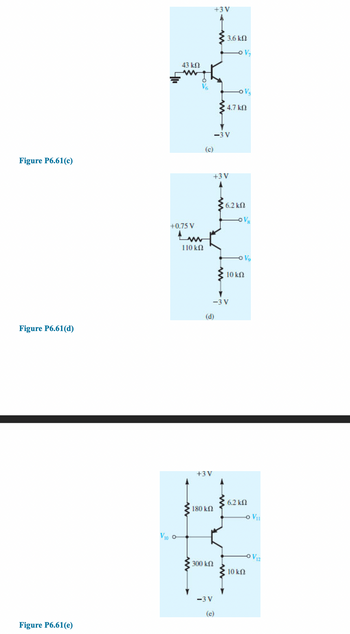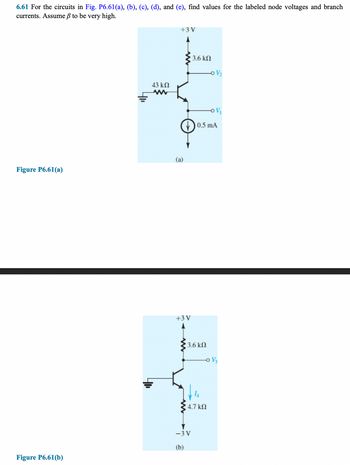
Introductory Circuit Analysis (13th Edition)
13th Edition
ISBN: 9780133923605
Author: Robert L. Boylestad
Publisher: PEARSON
expand_more
expand_more
format_list_bulleted
Concept explainers
Question

Transcribed Image Text:Figure P6.61(c)
Figure P6.61(d)
Figure P6.61(e)
43 ΚΩ
Α
+0.75 V
V100-
110 ΚΩ
ww
(c)
+3V
(d)
180 ΚΩ
300 ΚΩ
+3V
=3V
(e)
• 3.6 ΚΩ
=3V
+3V
47 ΚΩ
=3V
OV₂₁₂
OV
| 6.2 ΚΩ
V₂
-O V
10 ΚΩ
6.2 ΚΩ
10 ΚΩ
o VII
V12

Transcribed Image Text:6.61 For the circuits in Fig. P6.61(a), (b), (c), (d), and (e), find values for the labeled node voltages and branch
currents. Assume ß to be very high.
Figure P6.61(a)
Figure P6.61(b)
43 ΚΩ
www
+3V
(a)
+3V
3.6 ΚΩ
' 3.6 ΚΩ
-3V
(b)
1₁
4.7 ΚΩ
OV/₂
0.5 mA
-O V₁
-O V₂
Expert Solution
This question has been solved!
Explore an expertly crafted, step-by-step solution for a thorough understanding of key concepts.
This is a popular solution
Trending nowThis is a popular solution!
Step by stepSolved in 2 steps with 2 images

Knowledge Booster
Learn more about
Need a deep-dive on the concept behind this application? Look no further. Learn more about this topic, electrical-engineering and related others by exploring similar questions and additional content below.Similar questions
- Given the following image of a practical inductor, what is true? Practical REFF inductor RpC RAC L O Both Rpc and RAC are purposely built into the inductor. Both Rpc and RAC are characteristics of practical inductors, and not actual resistors. ORDC is purposely built into the inductor while RAc is not. O RAC is purposely built into the inductor while Rpc is not.arrow_forwardClamped Capacitor problem help. How did my textbook get this answer? I'm very confusedarrow_forwardA resistor of 20ohms and a capacitance of unknown value when connected. In in parallel across a 100V, 50Hz supply take a current of 6A. The combination is now connected across a 100V supply of unknown frequency and the current falls to 5.5A . What is the frequency?arrow_forward
- Please answer in typing format please ASAP for the like please clear the solution of Please answer in typing format please ASAP for Pleasearrow_forwardThe R-L Circuit: An inductor with an inductance of 2.50 H and a resistance of 7.00 n is connected to the terminals ofa battery with an emf of 6.00 V and an internal resistance of 1.00 n. What is the rate ofincrease of current at the instant when the current is 0.500 A? A) 0.8 A/s B) 0.6 A/s C) 0.4 A/s D) zero E) None of the above.arrow_forwardFor the following circuit, Vsrc=1.5 V and Rload%3D225 Q. What is Is? Is +. Vsrc VR Rload 30 mA 9 mA 6.67 mA 40 mVarrow_forward
- Q6. Explain why an a.c capacitor that is working in an a.c circuit will get hot, whereas a d.c capacitor working in a d.c circuit of the same voltage will not get hot.arrow_forwardIn the diagram below, the switch S has been closed for a long time. A) What is the output voltage Vout? What is the charge on the capacitor? b) The switch is opened, so the output voltage increases. What is the time constant that describes the charging of the capacitor in terms of R and C? c) When Vout reaches 10 V, the switch closes and the capacitor begins to discharge. What is the time constant that describes the discharging in terms of R and C? Hint: Apply Kirchhoff's Rules to both loops and the sum of the currents at the junction above the capacitor in the diagram, and use I=dq/dt. If the switch opens when Vout reaches a lower value, say 5V, the capacitor will charge again, and thus one can cycle the voltage with a time constant determined by the circuit: this demonstrates the principle of operation of an electronic timer. 4R S 15 V Vout Rarrow_forwardAn 8 mH inductor and a 2omega resistor are in series with a 20V battery. The switch is closed for t=0 at which the current is 0. Determine the potential across the inductor and across the resistor.arrow_forward
- -2•t mA (tis in 6.32 In the circuit below, the source current function is ig = 4.0.e second in this equation), and the voltage across each capacitor is equal to zero at t = 0. The capacitors = 21 UF , C2 = 13 UF , and C3 = 14 UF. Determine the v2 (in V) when t = 1.3 s. Please pay attention: the numbers may change since they are randomized. Your answer must include 1 place after the decimal point. %3D %3D %3D C3 + is V2 C2 10 Ω Your Answer: Answerarrow_forwardDraw a clearly labelled equivalent circuit showing the straycapacitors.arrow_forwardEXERCISE 6.3.11 (a) Determine the inductance at terminals A-B in the network below. 1mH AO LAB BO 1mH 12 mH 1mH 4 mH 6 mH 2 mH 2 mH 2mHarrow_forward
arrow_back_ios
SEE MORE QUESTIONS
arrow_forward_ios
Recommended textbooks for you
 Introductory Circuit Analysis (13th Edition)Electrical EngineeringISBN:9780133923605Author:Robert L. BoylestadPublisher:PEARSON
Introductory Circuit Analysis (13th Edition)Electrical EngineeringISBN:9780133923605Author:Robert L. BoylestadPublisher:PEARSON Delmar's Standard Textbook Of ElectricityElectrical EngineeringISBN:9781337900348Author:Stephen L. HermanPublisher:Cengage Learning
Delmar's Standard Textbook Of ElectricityElectrical EngineeringISBN:9781337900348Author:Stephen L. HermanPublisher:Cengage Learning Programmable Logic ControllersElectrical EngineeringISBN:9780073373843Author:Frank D. PetruzellaPublisher:McGraw-Hill Education
Programmable Logic ControllersElectrical EngineeringISBN:9780073373843Author:Frank D. PetruzellaPublisher:McGraw-Hill Education Fundamentals of Electric CircuitsElectrical EngineeringISBN:9780078028229Author:Charles K Alexander, Matthew SadikuPublisher:McGraw-Hill Education
Fundamentals of Electric CircuitsElectrical EngineeringISBN:9780078028229Author:Charles K Alexander, Matthew SadikuPublisher:McGraw-Hill Education Electric Circuits. (11th Edition)Electrical EngineeringISBN:9780134746968Author:James W. Nilsson, Susan RiedelPublisher:PEARSON
Electric Circuits. (11th Edition)Electrical EngineeringISBN:9780134746968Author:James W. Nilsson, Susan RiedelPublisher:PEARSON Engineering ElectromagneticsElectrical EngineeringISBN:9780078028151Author:Hayt, William H. (william Hart), Jr, BUCK, John A.Publisher:Mcgraw-hill Education,
Engineering ElectromagneticsElectrical EngineeringISBN:9780078028151Author:Hayt, William H. (william Hart), Jr, BUCK, John A.Publisher:Mcgraw-hill Education,

Introductory Circuit Analysis (13th Edition)
Electrical Engineering
ISBN:9780133923605
Author:Robert L. Boylestad
Publisher:PEARSON

Delmar's Standard Textbook Of Electricity
Electrical Engineering
ISBN:9781337900348
Author:Stephen L. Herman
Publisher:Cengage Learning

Programmable Logic Controllers
Electrical Engineering
ISBN:9780073373843
Author:Frank D. Petruzella
Publisher:McGraw-Hill Education

Fundamentals of Electric Circuits
Electrical Engineering
ISBN:9780078028229
Author:Charles K Alexander, Matthew Sadiku
Publisher:McGraw-Hill Education

Electric Circuits. (11th Edition)
Electrical Engineering
ISBN:9780134746968
Author:James W. Nilsson, Susan Riedel
Publisher:PEARSON

Engineering Electromagnetics
Electrical Engineering
ISBN:9780078028151
Author:Hayt, William H. (william Hart), Jr, BUCK, John A.
Publisher:Mcgraw-hill Education,